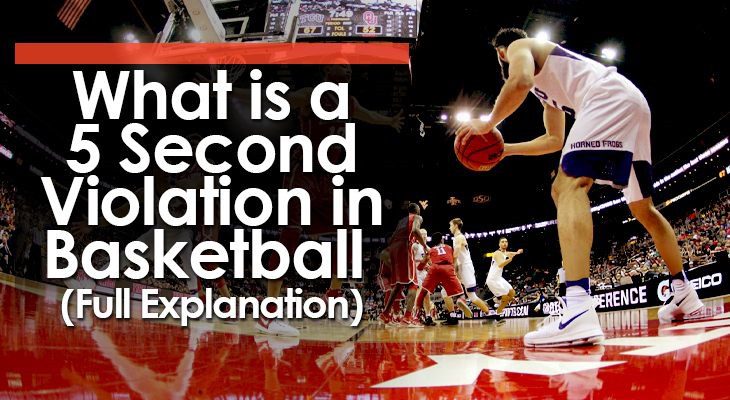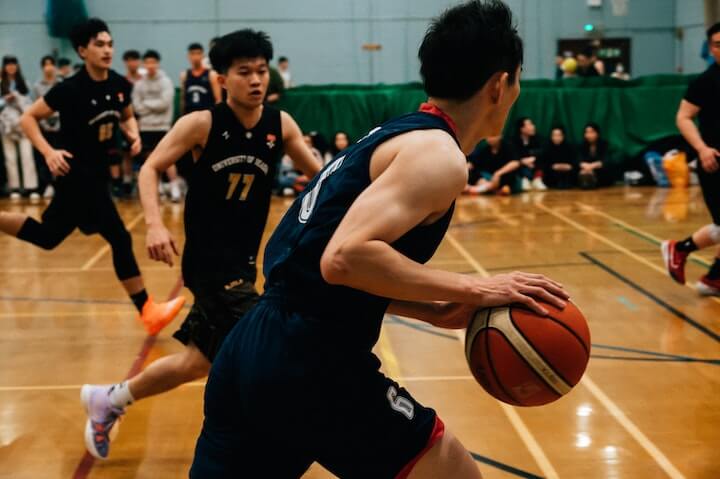[ad_1]

The 5 second violation is a common occurrence in every basketball game.
And the reason it is so common is because it can be called in a variety of different situations on the basketball court.
But even though the call itself is common, there are slight differences on the 5 second violation for different levels of basketball.
This article will take a look at different variations of the 5 second violation and how you can help your team avoid getting called for it.
What Is the 5 Second Violation in Basketball?
There are 2 different versions of the 5 second violation that high school and youth teams can run in to:
1. Throw-In Violation
Whenever an offensive player inbounds the basketball, whether it is against a press in the back court or an out-of-bounds play in the front court, they have 5 seconds to throw the ball in.
The count begins when the offensive player picks up the ball or is handed the ball by a referee and continues until the ball is released.
2. Closely Guarded
Once a player catches the ball, they have 5 seconds to either shoot, dribble, or pass the basketball.
The count gets reset whenever the offensive player is able to get their head and shoulders beyond the defender or break the required distance from the defender.

Why Is the Purpose of the 5 Second Violation?
The 5 second violation is a rule to improve the overall flow of the game.
If the offense can take as long as they want to initiate offense or throw the ball inbounds, it creates an unfair advantage for them.
The 5 second violation helps reward the defense for guarding the ball or inbounds play well.
What’s the Penalty for a 5 Second Violation?
The penalty for a 5 second violation is a deadball turnover by the offense.
The defense will be granted possession on the baseline if it was a violation on an inbounds play or closest to where the violation occurred if it’s for closely guarded.
Variations of the Closely Guarded Rule
Different levels have different basketball rules for the 5 second closely guarded violation.
In NCAA men’s basketball and in high school, the defender needs to be within 6 feet of the ball in the front court to force a count.
However, in NCAA women’s basketball, the distance is 3 feet and can occur anywhere on the basketball court.
At the NCAA level, whether men’s or women’s, the closely guarded count can only occur when the ball is behind held by the offensive player.
However, at the high school level, the count can occur whether the ball is being held or dribbled.
The last variation has to do with who exactly is guarding the ball. In NCAA basketball, the same defender must be within the required distance to keep the count going.
But at the high school level, even if the defense switches, the count can continue as long as they remained within 6 feet.
Teaching Players to Avoid the 5 Second Violation
Getting called for a 5 second violation is an instant backbreaker for an offense, especially late in a game.
Here are a couple key points to keep in mind for each variation of the 5 second violation to help your team avoid getting called for it.
Throw-In 5-Second Violation
a. Always have a safety valve
Every basketball coach loves to be able to score on the BLOB plays.
It’s a great way for your team to steal points, especially in a close game.
However, as a season goes on, your opponents will have the advantage of scouting your team.
Meaning the opportunity to score on your primary actions gets more and more difficult as the season goes on.
So you must make sure each of your BLOB plays has a player as an outlet that you can inbound the ball to as time is running out.
Typically this means a player who goes deep near the top of the key.
Because while scoring off your BLOB plays is a huge benefit for your offense, getting called for a 5 second violation during one is instead a huge momentum changer for the defense and must be avoided.
b. Use a good passer as the inbounder
The player you assign to throw the ball in is a decision that cannot be taken lightly.
Because if your play is run to perfection, it doesn’t matter if you don’t have a player with the ball who can make the pass for the score.
But merely being a “good passer” isn’t the only requirement for this spot.
You need someone who can anticipate a play before it’s happening, reading the defense and seeing what will likely happen based on how they are lined up.
They need to be able to make split-second decisions, because if they hesitate the play will no longer be open.
Putting your point guard at this spot is a common way to go, and that should work since that player should be able to pass well.
However, sometimes a player with a little more size to be able to see over defenders is an even better option if you can do it.
Closely Guarded 5-Second Violation
a. Watch the referee
Asking a player to know what 6 feet is on the court as the game is going on is a big ask.
But what your players need to realize is the referee will always show if a player is being closely guarded or not based on their hand signals.
If the defense is too far away, the referee will have both hands out, showing that the defense is too far away to begin a count.
However, if the defensive player is within 6 feet, the referee will extend and retract one of their arms to keep the count.
Seeing a referee’s hand signals will allow your players to know if they need to do something different with the ball or can continue to do whatever they are doing without fear of a turnover.
b. Know how to break the count
Just because a referee is counting doesn’t mean that the offensive player needs to automatically just shoot or pass the basketball.
Make sure your players understand how they can break the count by getting their head and shoulders by the body of the defender to reset the 5 seconds.
To do this, the offensive player must be strong with the basketball and able to rip by the defense with a quick first step to create separation.
Helping your players understand that if they are in trouble of turning it over that they can take a couple dribbles to buy themselves some more time with the basketball is an upper-level skill that will help your players develop quickly.

Conclusion
A 5 second violation call, whichever one it is, can be an absolute momentum-killer for an offense.
Not only does it result in a turnover by your team and you lose out on a chance to score, it injects the defense with more life and energy that can help them make a run.
So make sure your players know the different kinds of 5 second violations and how they can stay away from getting called for them.
Having a strong awareness of referees and defenders will help your players avoid getting in precarious situations.
And being able to make quick decisions to either pass or drive will also keep them in control of the ball and away from the 5 second violation.
[ad_2]
Source link





